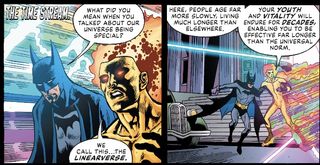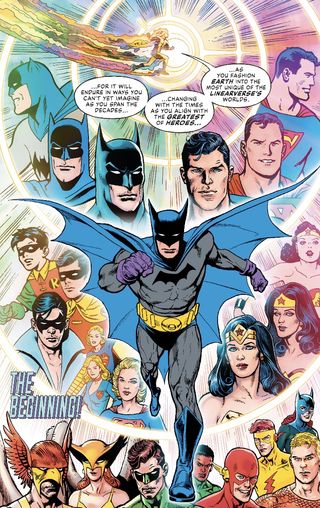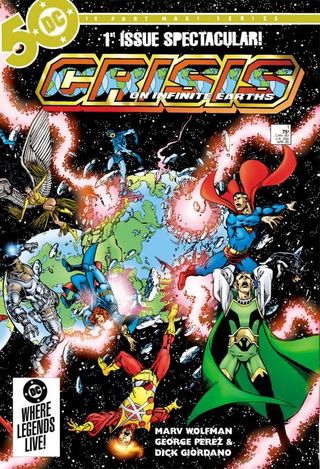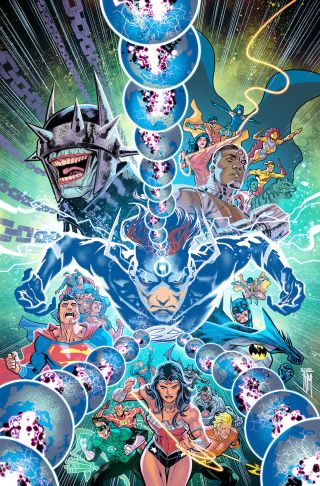DC introducing a new wrinkle to classic continuity
In DC's new Linearverse, the Batman from '40s, '70s, '90s, and 2021 are all the same guy

On Tuesday, February 23 DC is introducing the Linearverse - a new way to look at the publisher's 82-year-old history. Part of the new expanded Multiverse concept introduced in January's Dark Nights: Death Metal #7 called the Omniverse in which every DC story ever told is in continuity, the Linearverse somewhat ironically does away with the need for why the DC Multiverse was created for in the first place.
Got questions? Don't worry, we'll explain in detail. But first...
Spoilers for February 23's Generations: Forged #1

Generations: Forged #1 by writers Dan Jurgens, Andy Schmidt, and Robert Venditti is the second half of a story that began with a prologue in Detective Comics #1027 and which continued in January's Generations: Shattered #1. A sort of Avengers Forever-ish adventure, the story features a team of DC superheroes plucked from different timelines including the original 1939 Batman just weeks into his career assembled to battle a villain who is erasing time (for reasons that are somewhat similar to what's going on in Disney Plus's WandaVison).
A natural assumption about the Generations story in wake of the reveal that all stories are now in continuity in the new Omniverse is that heroes are plucked from different Earths from the Multiverse representing the different timelines. But that turns out not to be the case.
Instead, in Forged's final pages readers learn the despite all the familiar trappings of DC's past and future in the storyline like the original depictions of Superman's birth world of Krypton, it all actually takes place in its own new corner of the Omniverse called the Linearverse, in which all of DC's 80+ year history takes place in one singular and, of course, linear timeline on one Earth.
In other words, the Batman-Bruce that began his career in 1939 is the same Batman-Bruce Wayne who just took part in 2020's 'The Joker War.'

No multiple Earths, no Crises that rework timelines and continuity. Just heroes that live a very, very long time.
In the Linearverse, "people age far more slowly, living much longer than elsewhere," Waverider (a gatekeeper of DC's timelines) explains to Batman in the final pages of Forged. "Your youth and vitality will endure for decades, enabling you to be effective far longer than the universal norm."
Comic deals, prizes and latest news
Get the best comic news, insights, opinions, analysis and more!

The final pages also show renderings of multiple, iconic versions of Batman, Superman, Wonder Woman, Robin/Nightwing, and others, indicating that despite the changes in styles, all DC stories from their origin to the present day happened to the same people.
It's a simple, straightforward way to explain why fashions and technology changed, contemporary characters that are active in 2021 lived through historic events like World War II, and the heroes had far more adventures than can be reconciled within the 10-15 years that DC and even Marvel Comics superhero careers are generally regarded to be.
Co-writer Dan Jurgens tells Newsarama the Linearverse gives readers "a place that embraces a different concept of DC history."
Because people age differently in the Linearverse, Jurgens explains, Batman is "still young and vivacious enough to have operated as Batman through the 40s, 70s, 90s and all the way up to today. Despite being much, much older, Batman would still have the physique of a much younger man. Same with Robin.
"That isn't true for superheroes alone. Commissioner Gordon, for example, would have the same status."
The Linearverse is the formalization of an approach some writers like Grant Morrison unofficially took during their Batman days, but for the moment exists as a separate reality within the Omniverse.
"It's fair to say that what we built here, the Linearverse, is its own universe that can fit into the larger context of DC's Omniverse," explains Jurgens. "It's a place where some unique and individual stories can be told."
And while the methodology is simple, eliminating the need for Multiple Earths, alternate timelines, Crises, and reconciling the enduring nature of iconic fictional characters with the real world passing of time, DC continuity is never that simple.

Because so much of DC's storytelling has been preoccupied with creating a cohesive timeline for nearly 40 years now, the Linearverse requires some creative conceits to make it all work as well.
"Whenever you try to build these things, some accommodations have to be made because it's never a clean fit," answers Jurgens when asked about how stories like Frank Miller's seminal Batman: Year One from 1987 (which assumes Batman's early years took place in more contemporary times) fit into the Linearverse concept.
"Did something reasonably close to Frank's Year One happen? I'd like to think so, yes, and it would have been in the '30s," Jurgens continues. "Will we still get to the point where The Dark Knight Returns happens? That's in the future, as Bruce has not yet reached that general age.
"It isn't always the cleanest fit. But if you look at it as a set of puzzle pieces where you're permitted to sand a little off one edge, cut and trim another while adding a little putty to the next piece, you can pull it all together so it looks pretty damn good."
Jurgens was very clear that while this new Linearverse "is a place where some unique and individual stories can be told," that it also fits within the "larger context of the Omniverse." But close watchers of DC can't also help but wonder what may have been, and whether this approach was once slated to be official DC continuity.

Remember, Generations: Shattered and Forged is a somewhat reimagined version of what was intended to be, in early 2020, DC's big, universe-redefining event kicking off the new decade in five monthly installments, along with a Free Comic Book Day (FCBD) prologue.
Readers may recall nearly a year before the original Generations was to debut in May of 2020, then DC co-publisher Dan DiDio began teasing the upcoming definition of a new canonical DC timeline that began with Wonder Woman's appearance during World War I (Generation One), as first depicted in a Scott Snyder-written story in January 2020's Wonder Woman #750.
"The Generation series of specials are built to bring the new DC timeline to life," DiDio said in February 2020 of the original event. "We'll be shining a spotlight on the 80-plus-year publishing history of the DC universe while charting the course for the bright future of DC's characters. All of our greatest stories and events will create the backdrop and context for the great new adventures we have planned. Everything counts, and we guarantee there'll be surprises along the way!"
One surprise along the way was DiDio's abrupt exit from DC just days after this announcement. And while the FCBD special was officially scuttled and series delayed because COVID-19 effectively canceled FBCD, the entire event was later removed from DC's schedule to this day without an official explanation before resurfacing as Shattered and Forged.
Asked if the Linearverse was the endgame of the initial 2020 iteration of Generations, or if it came about during the process of developing what Generations would become, Jurgens tells Newsarama its origins go back to the original version.
"Ironically enough, this does reflect a bit of what Generations was in the beginning," the writer says. "There is still a fair amount of difference but the idea of telling a story that reflects DC's comics from the beginning on through the present is where we started. The journey's roadmap was filled with changes of direction, blocked roads, numerous flight changes, and a couple of wayward cruises that got lost at sea, but the project still retains aspects of our earliest conversations.

"DC's publishing history is a generational one. It is, after all, one of the reasons that we took characters from specific points in time through DC's history. It's amazing that these characters have endured as long as they have and it's remarkable to see how they've adapted to the times, while still retaining, in many cases, their original, core attributes."
Whatever the original intention, the Linearverse now exists as a playground in which new stories can be told within the Omniverse, and Jurgens and his co-writers ended the story practically inviting DC to explore it more.
Generations: Forged ends with Waverider gifting 1939 Batman with a time-travel device to be used only as a last resort in a "true Crisis" and the story's final words are "The Beginning!"
"There are all sorts of stories and adventures worth exploring in the Linearverse," Jurgens concludes. "If readers like what they've seen, react well to the concept, and ask for more, it might just happen."
Speaking of Crises, Newsarama ranked every Crisis in DC's history from best to worst.
I'm not just the Newsarama founder and editor-in-chief, I'm also a reader. And that reference is just a little bit older than the beginning of my Newsarama journey. I founded what would become the comic book news site in 1996, and except for a brief sojourn at Marvel Comics as its marketing and communications manager in 2003, I've been writing about new comic book titles, creative changes, and occasionally offering my perspective on important industry events and developments for the 25 years since. Despite many changes to Newsarama, my passion for the medium of comic books and the characters makes the last quarter-century (it's crazy to see that in writing) time spent doing what I love most.
Most Popular







